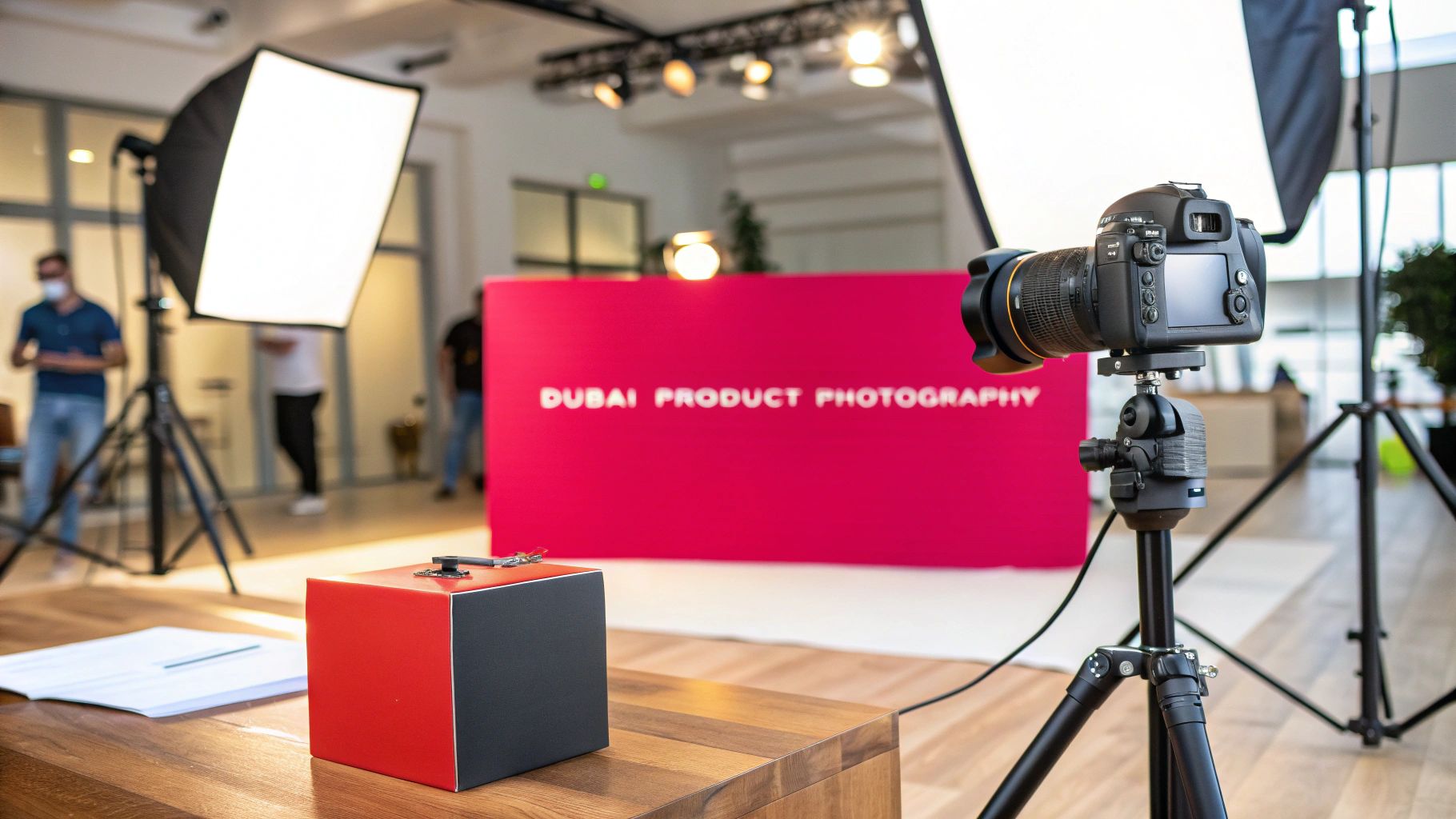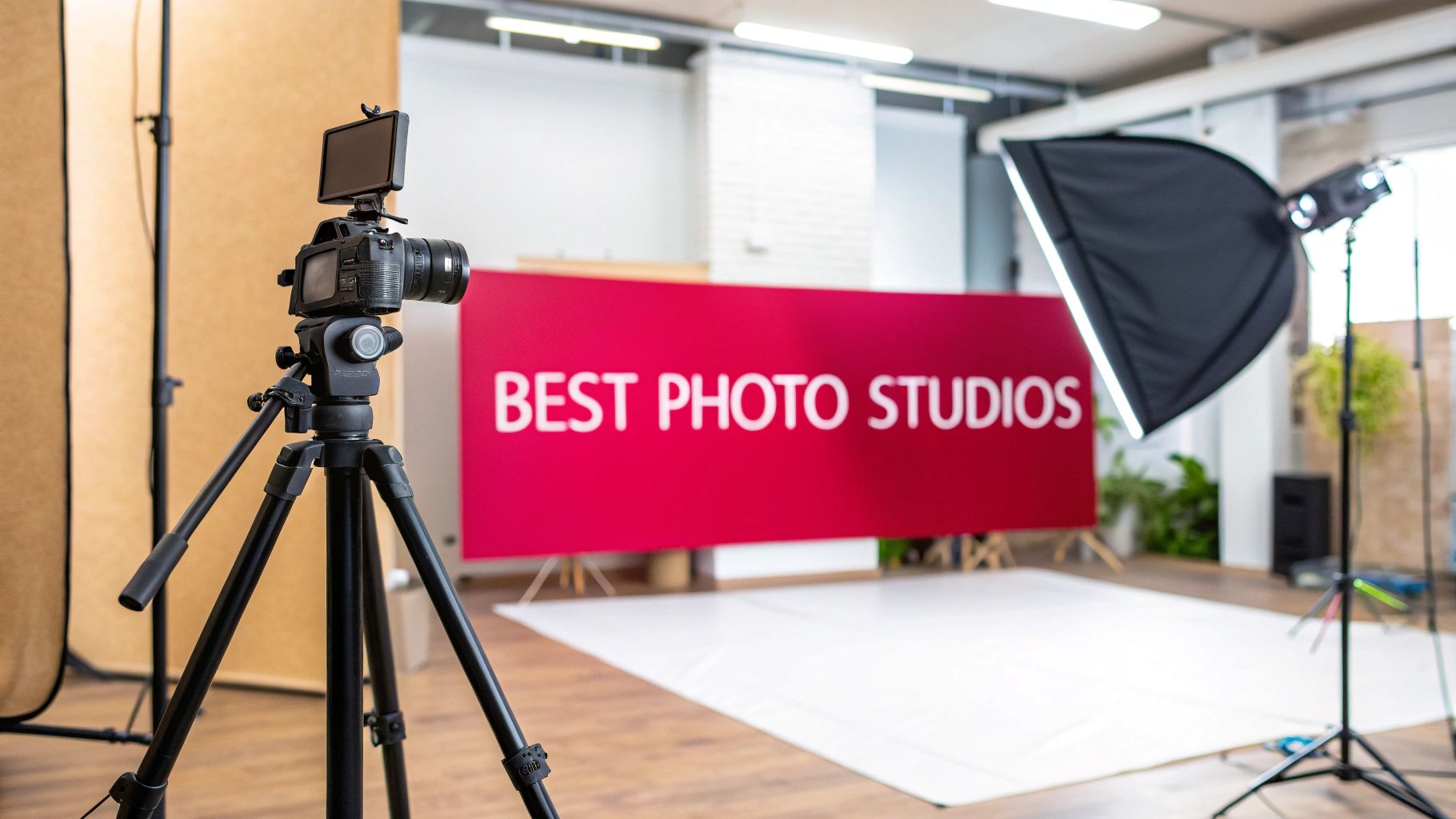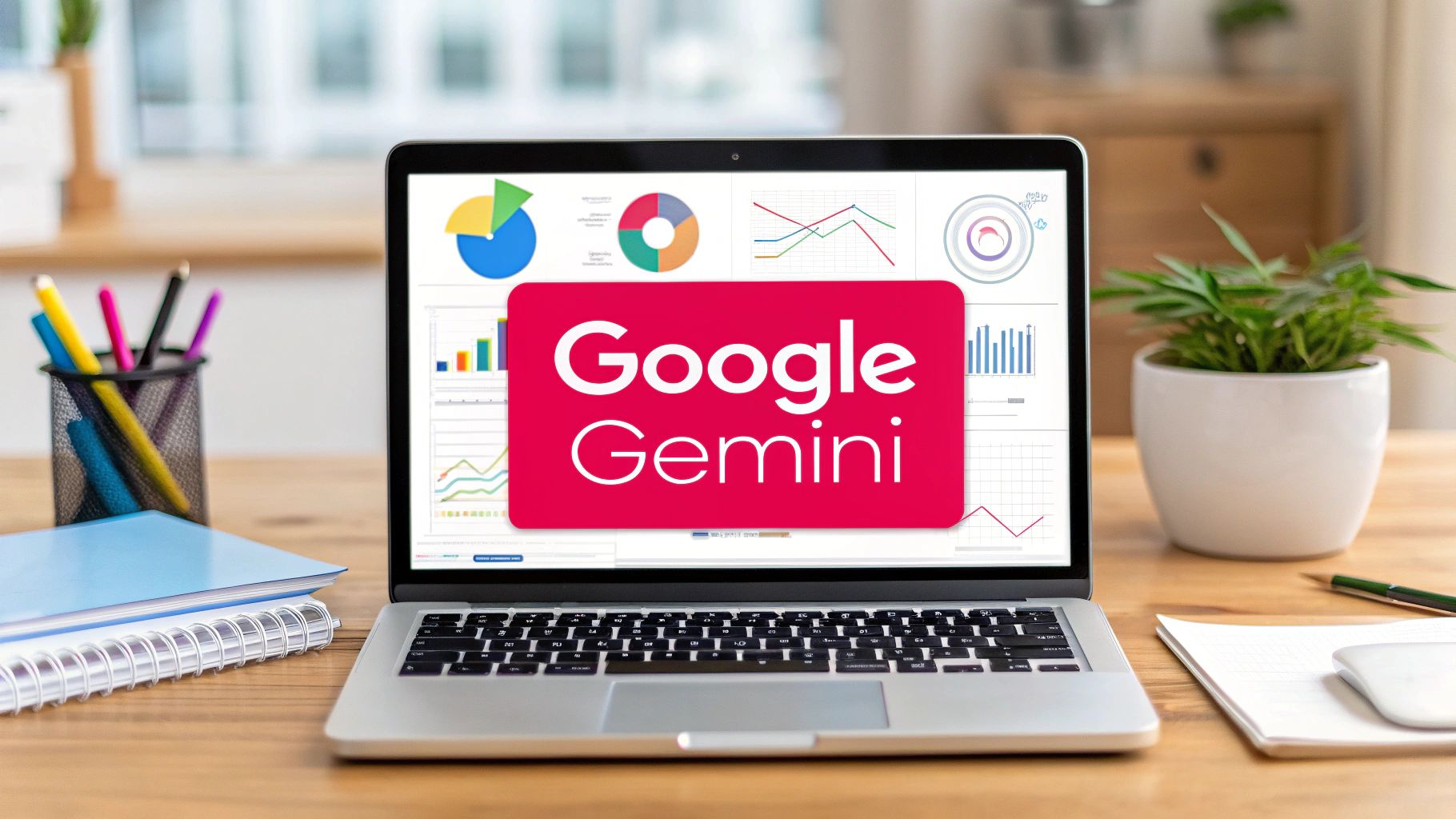In a place like Dubai, where everything is driven by aesthetics, your product photos are doing some serious heavy lifting. They're not just pictures. They're your brand's first handshake, the window display of your digital shop, and frankly, your most effective salesperson. Investing in high-quality product photography in Dubai isn't just a nice-to-have; it's the absolute first step to grabbing the attention of savvy customers, earning their trust instantly, and converting casual browsers into loyal fans.
Why Great Product Photography Is Essential in Dubai
In the UAE's high-speed commercial world, you only get one chance to make a first impression. Your product photography is that first point of contact. It's a silent conversation where quality, professionalism, and an eye for detail are communicated in a fraction of a second. Let's be honest, blurry or poorly lit images send a clear message: a lack of care. That can instantly devalue your product before a customer even bothers to read the description.
On the flip side, truly great photography gives your brand a major lift. It doesn't just display an item for sale; it tells a story, sparks an emotion, and creates a genuine sense of desire. Picture a luxury watch. A quick snap from a phone might show its basic shape, but a professional shot captures the precise glint of the metal, the rich texture of the leather strap, and the intricate craftsmanship of the watch face. That's how you communicate prestige without saying a word.
Build Trust and Justify Premium Value
Top-notch visuals are the bedrock of customer confidence. When people are shopping online, they can't touch or feel the product, so they're relying entirely on the images you give them. Crisp, clear, and perfectly lit photos signal that your business is credible and transparent. It reassures customers that what they see is exactly what they’re going to get.
This visual proof is also how you justify a premium price tag. In Dubai's crowded marketplace, people naturally connect high-end imagery with high-end quality. A well-shot photograph expertly highlights the fine materials, superior construction, and unique details that make your product worth the money. Suddenly, the price feels completely logical. This is a vital piece of the puzzle for brand positioning and a cornerstone of any smart strategy for advertising in Dubai.
Reduce Returns and Set Clear Expectations
One of the most practical, bottom-line benefits of professional product photography is a sharp drop in return rates. When you provide detailed, accurate images from every conceivable angle, you set crystal-clear expectations. Customers know exactly what they're buying and feel confident hitting that "add to basket" button.
When the product that arrives at their door looks precisely like it did online, satisfaction levels go through the roof, and the chances of a return plummet.
In e-commerce, your images are the product until the real one is in the customer's hands. Getting them right isn't just a marketing decision; it's a fundamental part of good customer service and operational efficiency.
The demand for killer visuals is clearly reflected in market trends. Driven by the e-commerce explosion, Dubai's photo printing and photography market has grown significantly. This boom is powered by a simple fact: the vast majority of online purchases start with a search and a close look at the product images. Ultimately, high-quality product photography is a massive factor in helping brands to improve your overall e-commerce conversion rates.
Choosing Your Product Photography Style
Picking the right photographic style is a bit like choosing the perfect outfit for a big event. It has to fit the occasion, show off your personality, and make a strong impression. For your products, this choice is crucial—it shapes how customers see your brand and can be the deciding factor in making a sale.
When you're looking at product photography in Dubai, the style you land on isn't just about aesthetics; it's a strategic business decision.
You have to think about your product and who you're selling to. Are you listing items on a high-volume marketplace like Noon or Amazon, where clarity is king? Or are you trying to build an aspirational brand on Instagram that needs to tell a story? Each platform has its own visual language. Let's walk through the most common styles to figure out which one is the perfect match for you.
E-commerce and White Background Shots
You know those clean, crisp images you see on every major online store? That's the classic white background or e-commerce photography style. Its job is simple: show the product clearly, with absolutely no distractions. For straightforward product listings, it's the undisputed champion.
This minimalist approach gives your entire product catalogue a professional, organised feel. By stripping away all the background noise, you force the customer's eye to focus on what matters—the product's shape, colour, texture, and features. For businesses selling on platforms with strict image guidelines, this style isn't just a good idea; it’s often a non-negotiable requirement.
Lifestyle and In-Context Photography
If white background shots inform, then lifestyle photography inspires. This style is all about placing your product in a real-world setting to tell a story. It helps customers imagine how your product would actually fit into their lives, creating an emotional connection that goes beyond just specs and features.
Think about it: a luxury watch isn't just a device for telling time; it's a statement piece. A lifestyle shoot might capture it on someone's wrist as they look out over the Dubai Marina. A new kitchen gadget might be shown in a bright, busy family kitchen. This approach is pure gold for social media, blogs, and website banners where grabbing attention and building a vibe is everything.
Lifestyle photography transforms a simple product into an aspirational experience. It answers the customer's unspoken question: "How will this product make my life better, more stylish, or more enjoyable?"
This decision tree really drives home how vital high-quality images are for building trust and closing sales in Dubai's crowded market.
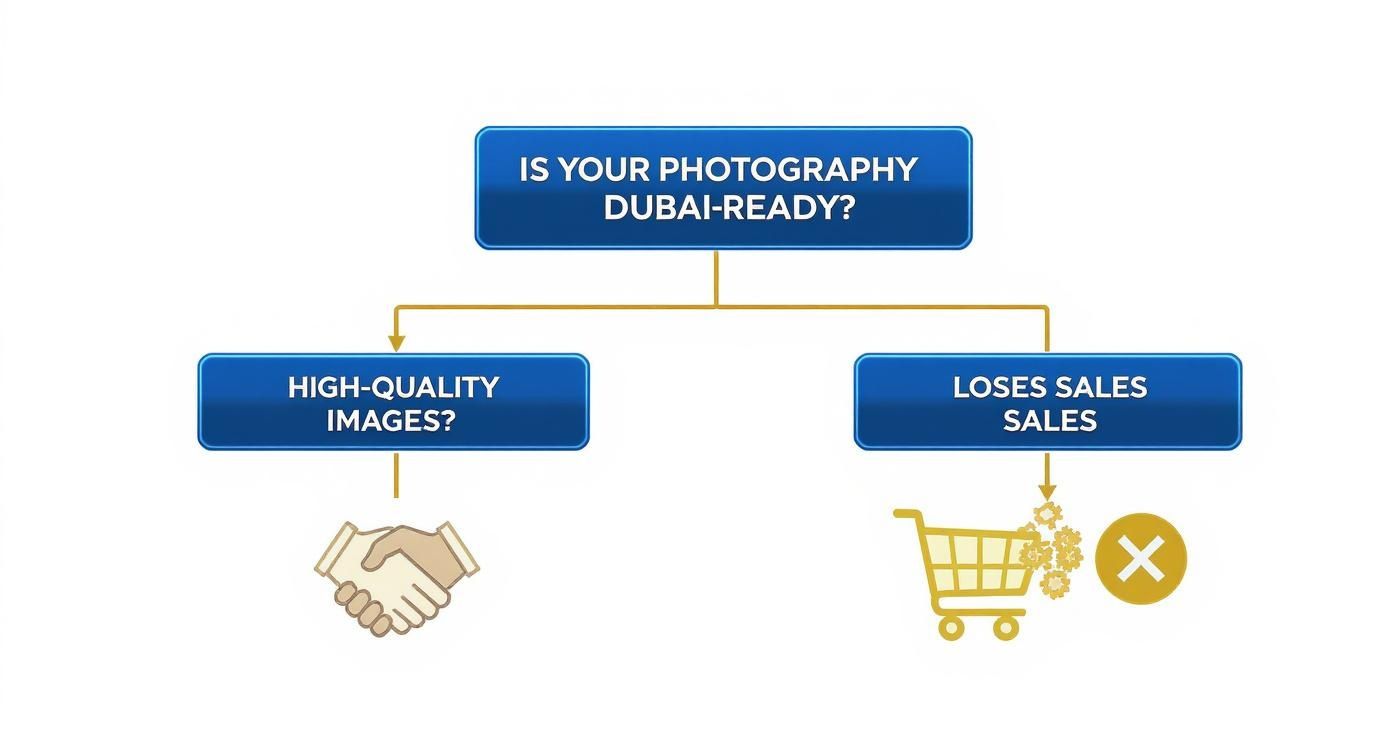
As you can see, investing in professional shots is a direct path to earning customer trust. On the flip side, poor imagery is a fast track to lost sales.
Detailed Close-Ups and 360-Degree Views
For products where the devil is in the details, detailed close-ups (or macro shots) are a must. This style zooms in on the intricate features that justify a higher price tag—things like the delicate stitching on a leather handbag, the texture of a premium skincare cream, or the precision-cut facets of a gemstone.
Want to take it to the next level? 360-degree photography gives your customers an interactive, almost-in-your-hands experience. By letting them spin the product around and inspect it from every conceivable angle, you're essentially recreating the feeling of picking it up in a physical store. This transparency builds massive confidence and has been proven to give conversion rates a serious boost, especially for things like electronics, furniture, and fashion.
Comparing Product Photography Styles for Your Business
To help you decide, here’s a quick breakdown of the different styles and where they shine. Think of this as your cheat sheet for choosing the right visual strategy.
| Photography Style | Primary Use Case | Key Benefit | Ideal For |
|---|---|---|---|
| E-commerce/White Background | Product listings on marketplaces and online stores. | Clarity, consistency, and compliance. | Amazon/Noon sellers, large catalogues, electronics, apparel basics. |
| Lifestyle/In-Context | Social media, ads, blogs, and website banners. | Creates an emotional connection and story. | Fashion brands, home decor, food and beverage, high-end consumer goods. |
| Detailed Close-Ups | Highlighting quality and unique features. | Showcases craftsmanship and builds trust. | Jewellery, luxury accessories, cosmetics, artisanal goods. |
| 360-Degree View | Interactive product pages on e-commerce sites. | Boosts confidence and reduces returns. | Footwear, furniture, complex electronics, and high-consideration items. |
Ultimately, the most successful brands don't just stick to one style. They use a smart mix of all of them—crisp e-commerce shots for the product page, inspiring lifestyle images for Instagram, and detailed close-ups to highlight what makes their product special.
Studio Shoots Versus On-Location Photography
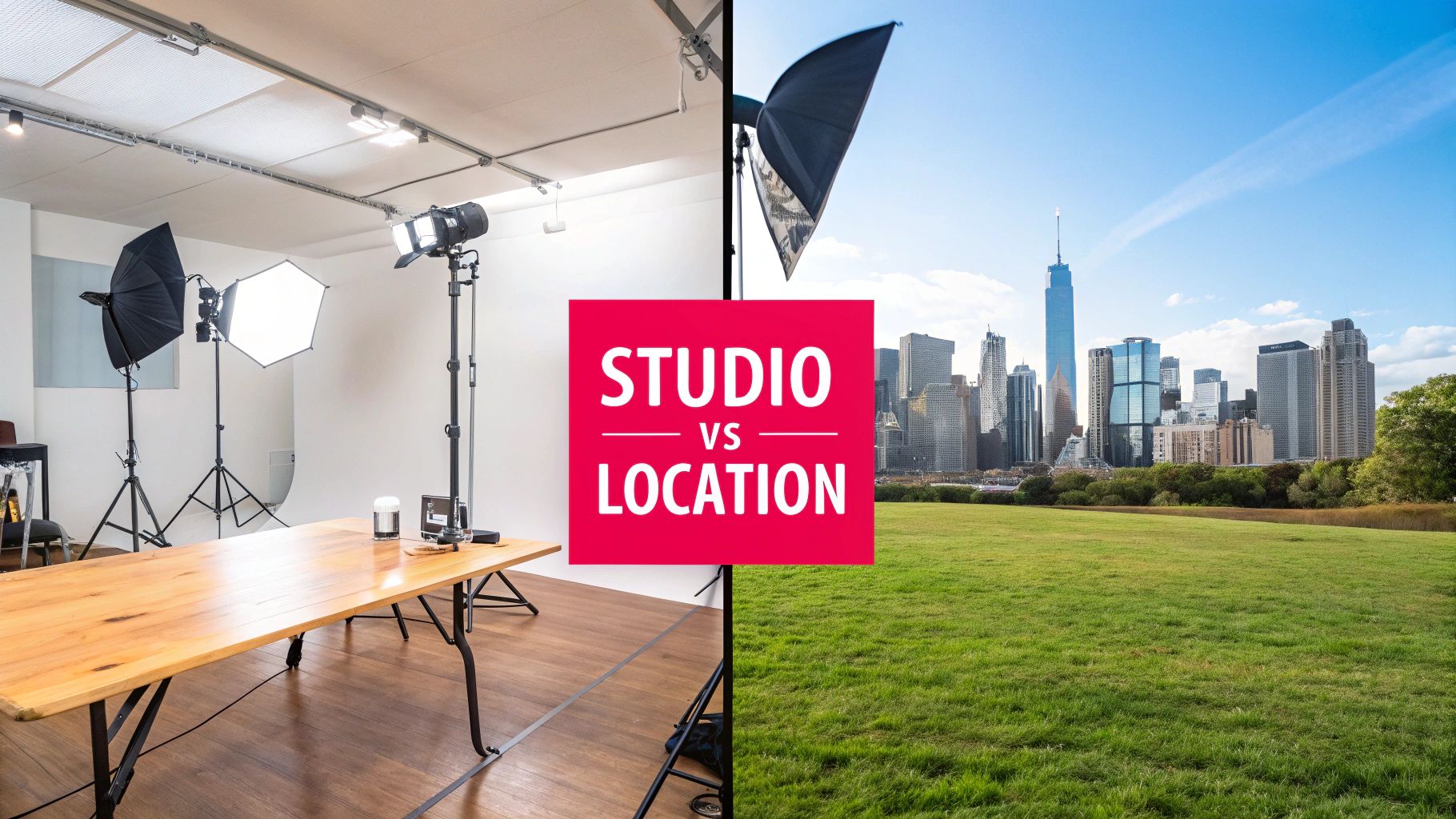
One of the first big decisions you'll make is where to shoot your products. This choice is about more than just a background; it fundamentally shapes how customers see your brand. It’s a strategic fork in the road: do you go for the controlled precision of a studio or the dynamic, real-world narrative of an on-location shoot?
Each path offers its own unique advantages, and the right one really boils down to your product, your brand's personality, and what you’re trying to achieve with your marketing. This isn't just about aesthetics—it's about aligning your visual strategy with your business goals. For brands that need a high volume of crisp, consistent images for an e-commerce site, the studio is a no-brainer. But for those aiming to build an emotional connection and tell a story, the iconic landscapes of Dubai provide an unbeatable stage.
The Power of a Controlled Studio Environment
Think of a photography studio as a creative laboratory. It’s a blank canvas where every single variable is under the photographer’s complete command. From the exact angle and intensity of the light to the texture of the backdrop, there are no surprises like a sudden cloudburst or fading daylight.
This meticulous control is the secret to achieving absolute consistency across your entire product range. Whether you’re photographing ten items or a thousand, each image will have the same lighting, style, and feel. That uniformity creates the clean, professional, and trustworthy look that top e-commerce stores are known for.
A studio shoot is all about perfection and predictability. By stripping away distractions, it puts your product in the spotlight, allowing customers to focus entirely on its features, quality, and craftsmanship.
Studios are also efficiency powerhouses. Everything the team needs—lighting rigs, backdrops, props, and even editing stations—is right there. This setup is perfect for working through large product catalogues quickly and cost-effectively, getting your items online and in front of customers that much faster.
Creating a Narrative with On-Location Shoots
If a studio offers precision, then on-location photography offers personality. Taking your products out into the world instantly gives them context and places them within a desirable lifestyle. An on-location shoot turns Dubai’s stunning scenery—from the golden desert dunes to the sleek, futuristic architecture of Downtown—into a powerful character in your brand’s story.
Just imagine a new line of activewear shot against the vibrant energy of Kite Beach at sunrise. Or picture a luxury handbag featured in a chic, bustling café in DIFC. These settings do more than just look good; they build a narrative that helps customers see themselves using your product in their own lives. It's an approach that works wonders for social media campaigns, lookbooks, and website banners where storytelling is king.
What’s more, the content you capture on location is incredibly versatile. Behind-the-scenes clips and B-roll footage from the photoshoot are pure gold for creating engaging video content for Instagram Reels, TikTok, or your website. Experts in corporate video production in Dubai can show you just how valuable repurposing this kind of visual content can be.
How to Choose the Right Setting
So, how do you decide? It really comes down to your core needs. Here’s a simple way to think about it:
- For E-commerce Platforms: If your main goal is to get clean, uniform product shots for your listings on Amazon, Noon, or your own website, the studio is your best friend.
- For Brand Storytelling: If you want to build an aspirational brand, connect with your audience on an emotional level, and create knockout social media content, nothing beats an on-location shoot.
- For Product Type: The product itself can often point you in the right direction. A high-end watchmaker will need the hyper-detailed, controlled lighting of a studio to capture every intricate detail. On the other hand, a brand selling rugged outdoor gear gains far more credibility by showing its products thriving in the very environments they were built for.
How Product Photography Pricing Works in Dubai
Trying to figure out how much professional photography will cost is a big step when you're planning your brand's budget. When it comes to product photography in Dubai, you won’t find a simple price list. Instead, pricing is built around the specific needs of your project, and understanding what goes into that final number helps you have smarter conversations with photographers.
Most photographers in Dubai will quote you in one of three ways: per image, per hour, or for a full day. Each has its place, and the right one for you really depends on what you’re trying to achieve. Let's get into what they mean so you can make a solid financial choice.
Common Pricing Models Explained
Getting a handle on the typical pricing structures is the first step. It'll make it much easier to compare quotes from different photographers and see what you're really paying for.
-
Per-Image Rate: This is as straightforward as it gets. You pay a fixed price for every final, edited photo. It’s perfect for smaller jobs, like if you're launching a new product or just need a handful of top-notch shots for your e-commerce site.
-
Hourly Rate: When a project is a bit more fluid, an hourly rate makes more sense. Think of lifestyle shoots where you’re capturing a mood, or sessions where you want to get a bunch of different shots within a set timeframe.
-
Day Rate / Half-Day Rate: If you have a mountain of products to get through or a complicated on-location shoot, booking a photographer for a half or full day is usually the smartest move financially. It gives you a dedicated chunk of time to get everything done without constantly checking your watch.
This kind of flexibility is crucial in a market as vibrant as the UAE. Commercial photography plays a huge role here. In fact, the Middle East's stock photo market, where the UAE is a major contributor, was valued at $68.5 million and is set to keep growing. You can discover more about the visual content market trends on cognitivemarketresearch.com.
Key Factors That Influence the Final Quote
So, beyond the basic pricing model, what else shapes the final quote? A few key things come into play, covering the time, expertise, and gear needed to make your vision a reality.
Think of a photography quote less like a price tag and more like a project proposal. It reflects not just the final images, but the entire creative process, from initial concept planning to final delivery.
The complexity of your product is a huge one. Snapping a photo of a t-shirt is one thing. But shooting a piece of reflective jewellery or a glass bottle? That's a whole different ball game, requiring tricky lighting to avoid glare and capture every little detail.
Then there's the creative and production side of things, which can really add to the cost.
-
Styling and Props: Does the shoot need a professional stylist to make your products look their best? Do you need to track down specific backgrounds, props, or textures to create the right vibe?
-
Models and Locations: Bringing in professional models, renting a stunning villa, or getting the right permits to shoot at an iconic Dubai location will all be factored into the budget.
-
Post-Production Work: The amount of editing required after the shoot is a massive factor. Basic colour adjustments are standard, but if you need advanced work like creating composite images (stitching multiple photos together) or detailed background removal, that takes a lot more time and skill.
Finding the Right Product Photographer in Dubai
Picking a product photographer is less about hiring a vendor and more about finding a creative partner. This isn't just someone who points a camera and clicks; they're the one responsible for turning your brand’s story and your product's best features into images that actually sell. In a market as visually competitive as Dubai, getting this choice right can make all the difference.
You're not just looking for someone with a nice camera. The real work is in finding a professional whose style clicks with your brand, who has genuine experience, and who you can collaborate with effectively. You need someone whose creative eye aligns with your vision and who has a solid history of making products like yours look incredible.
Analysing Portfolios for Style and Expertise
First things first, get ready to do a deep dive into portfolios. Don’t just skim through the pretty pictures. Really look at them. What’s the consistent style? Is it bright, clean, and airy, or does it lean more towards dark, moody, and dramatic? Your brand has a personality, and the photographer’s style needs to match it.
Go beyond the general feel and look for experience with products in your category. A photographer who’s a genius at shooting sleek, high-fashion apparel might not have the nuanced lighting skills needed to capture the complex reflections on a piece of jewellery or the delicate texture of a gourmet food item. Look for proof that they understand your product’s specific needs.
It's interesting to see how much things have changed, especially with the rise of amazing smartphone cameras. In the UAE, smartphones are now used for over 70% of all image capturing. This has pushed everyone—even small businesses—to up their game with professional-quality photos, making the entire market more competitive. You can read the full research on this market transformation on cognitivemarketresearch.com.
Key Questions to Ask Potential Photographers
Once you’ve got a shortlist of photographers whose work you love, it’s time to start a conversation. The goal here is to get a feel for their process and communication style. Asking the right questions now can save you a world of headaches later on.
Here are a few essential questions to get the ball rolling:
- Process and Collaboration: "Could you walk me through your typical creative process, from when we first chat to when you deliver the final photos?"
- Timelines: "For a project like ours, what's a realistic turnaround time?"
- Image Delivery: "How will we receive the final images, and what kind of usage rights are included in the price?"
- Revisions: "What happens if the first round of shots isn't quite what we had in mind? What's your policy on revisions or reshoots?"
These questions aren't just about logistics; they reveal how professional and organised a photographer is. This is especially crucial if you're working with other creative partners, as the best production companies in Dubai depend on everyone hitting their deadlines to keep a project running smoothly.
Verifying Credentials and Building Rapport
A stunning portfolio and technical skill are the baseline, but that’s only half the story. You also need to be sure they’re reliable and that you can build a good working relationship with them.
Start by digging into client testimonials and reviews. Look for comments about their professionalism, how they communicate, and whether they delivered what they promised. A long list of happy clients is one of the best signs you've found a good one.
Your photographer is more than a vendor; they are a key creative partner. A strong rapport built on clear communication and mutual respect is often the secret ingredient behind a successful and stress-free photoshoot.
Finally, hop on a quick call or meet for a coffee. This is your gut-check moment. Do your personalities mesh? A great photoshoot is a team effort, and feeling comfortable and confident with your photographer is absolutely essential to bringing your vision to life.
How to Prepare for a Successful Photoshoot
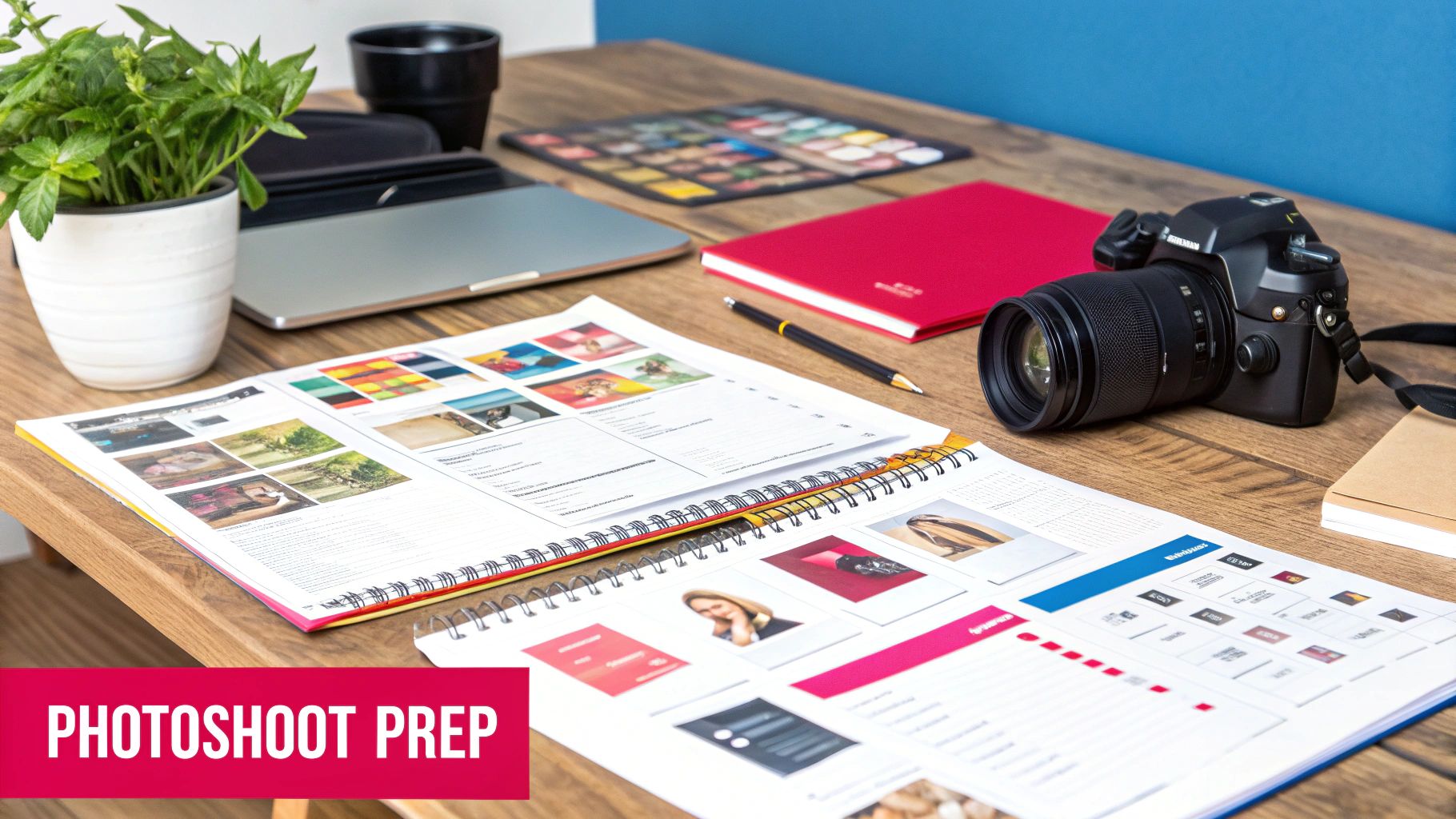
Fantastic product photos don't just happen by chance. They're the direct result of careful planning and clear communication long before anyone even picks up a camera. Getting this prep work right ensures the final images nail your brand’s vision and saves you from a world of headaches and costly delays down the line.
Think of it like building a house. You wouldn't just show up with a pile of bricks and hope for the best; you'd need a detailed blueprint. Your photoshoot prep is that blueprint.
Crafting the Creative Brief
The creative brief is your single most important document. It’s the master plan that translates your vision into a language the photographer can execute perfectly, leaving absolutely no room for interpretation or guesswork. It needs to be detailed, visual, and crystal clear.
Your brief should have three non-negotiable parts:
- A Detailed Shot List: This is your checklist for the day, itemising every single image you need. Get specific. Mention angles, how products should be grouped, and any key features you want to show off.
- A Mood Board: Words can only go so far. A mood board—a collection of images, colours, and textures that capture the feel you're after—communicates the aesthetic instantly.
- Brand Guidelines: Don't forget to include your brand’s rules on logo usage, your exact colour palette, and specific fonts. This ensures every photo feels like it belongs to your brand.
Preparing Your Products
The modern camera is incredibly detailed, and it will pick up on every tiny imperfection. Your products need to be in absolutely pristine condition before they get anywhere near the set.
Inspect every item under a bright light. We’re talking no dust, no fingerprints, no smudges, and no stray price tags or labels that shouldn't be there. If you’re shooting clothing, every piece must be perfectly steamed or ironed. Wrinkles are the enemy.
Remember, while a talented retoucher can work magic, it's always faster and cheaper to get the product looking perfect from the start. Every minute spent fixing things in post-production is a minute (and money) you could have saved with better prep.
Managing Photoshoot Day Logistics
On the day of the shoot, all your careful planning comes to life. Getting the logistics right is the key to keeping everything running smoothly and keeping stress levels low.
First up: transport. Figure out how your products will get to the studio or location safely. Pack them securely to prevent any scratches, dents, or damage along the way. If you’re shooting on-location, confirm all the access details and any necessary permits well in advance. You don't want any last-minute surprises.
It's also a great idea to have a key decision-maker on set, either in person or available on a video call. This allows for instant feedback and approvals, so the photographer knows they're hitting the mark. This kind of real-time collaboration is the best way to avoid the dreaded "we need a reshoot" conversation. Finally, to make sure your images load quickly on any website or platform, plan for post-production tasks like optimizing image file sizes without losing visual quality.
Frequently Asked Questions
Stepping into the world of professional product photography for the first time can feel a little daunting, especially in a market as vibrant as Dubai. Let's tackle some of the most common questions that pop up, giving you the clarity you need to move forward with your brand's visual identity.
How Much Should I Budget for Product Photography in Dubai?
This is the big question, and the honest answer is: it varies. A straightforward e-commerce shoot for a handful of products on a white background could be a few thousand dirhams. On the other hand, a full-scale lifestyle shoot with models, a unique location, and a whole creative team will naturally be a much larger investment.
The best way to figure this out is to get detailed quotes from a few different photographers based on a solid creative brief.
Try to think of it less as a cost and more as an investment in your brand. Great images have a direct line to your sales and how customers see you, often paying for themselves many times over.
How Long Does a Product Photoshoot Take?
The timeline is completely tied to the project's size and complexity. A simple studio session with a small product line might just take half a day.
But if you're planning something bigger—multiple setups, different locations, and a lot of detailed editing work—you could be looking at several days or even a couple of weeks from the first conversation to getting your final, polished images. The key takeaway? Clear communication with your photographer about your deadlines is absolutely essential.
Do I Need to Hire a Professional Stylist?
For clean, simple product shots against a white backdrop, you might not need a stylist, as long as you prep your products perfectly.
However, when you get into lifestyle or in-context shots, a professional stylist is worth their weight in gold. These are the experts who know exactly how to arrange products, find the right props, and build a scene that tells a story. They can take your product photography in Dubai from good to absolutely unforgettable.
What Usage Rights Will I Get for My Photos?
This is a critical detail to sort out before you sign anything. Typically, the price you pay covers a specific set of usage rights—think your website, social media channels, and online ads for an agreed-upon amount of time.
If you have bigger plans, like using the images for billboards or print campaigns, that usually requires a separate licensing agreement and will come with additional costs. Always get the usage rights clearly outlined in writing. It’s the best way to avoid any confusion down the road.
Ready to create stunning visuals that make your products stand out? Grassroots Creative Agency specialises in crafting compelling product photography that captures attention and drives sales in the competitive Dubai market. Visit us to learn how we can elevate your brand's image.
